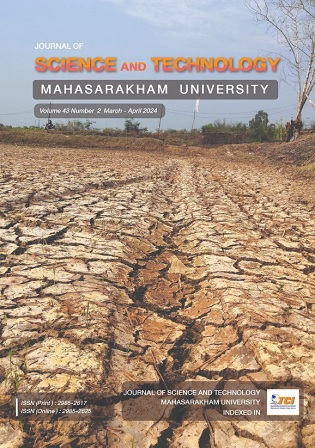การสังเคราะห์อย่างรวดเร็วของคลาสส่วนน้อยโดยใช้เครือข่ายฝ่ายตรงข้ามเชิงกำเนิดสำหรับปัญหาการจำแนกประเภทข้อมูลที่ไม่สมดุล
Main Article Content
บทคัดย่อ
อัลกอริทึมเครือข่ายฝ่ายตรงข้ามเชิงกำเนิด (แกน) คือ คลาสของเครือข่ายประสาทแบบเชิงลึก ที่สามารถสร้างตัวอย่างข้อมูลในสถานการณ์ข้อมูลที่ไม่สมดุลได้ ซึ่งแกนประกอบด้วย 2 ส่วนที่เกิดขึ้นพร้อมกัน ได้แก่ ส่วนการสร้างแบบจำลองเชิงกำเนิด และส่วนแยกแยะ โดยส่วนการสร้างแบบจำลองเชิงกำเนิดจะสุ่มข้อมูลจากชุดข้อมูลฝึกสอน และส่วนแยกแยะจะดำเนินการแยกแยะข้อมูลจากข้อมูลตัวอย่างที่สร้างขึ้นและจากข้อมูลจริง การวิจัยนี้ศึกษาการถ่ายโอนข้อมูลที่ทับซ้อนกันระหว่างการสร้างแบบจำลองบนข้อมูลแบบสตรีมมิงในเวลาเรียลไทม์ โดยนำเสนอวิธีการสร้างส่วนขยายใหม่บนแกนที่เรียกว่า แกนทูที (GANs2T)
บนพื้นฐานของอนุกรมเวลาแบบตาราง เพื่อเพิ่มประสิทธิภาพการทำงานของแบบจำลองและระยะเวลา ซึ่งใช้วิธีการจับข้อมูลโครงสร้างของค่าความแปรปรวนร่วมกันของข้อมูลจากคลาสกลุ่มน้อย และสร้างข้อมูลสังเคราะห์จากความน่าจะเป็น ด้วยการใช้อัลกอริทึมนี้เรียนรู้ข้อมูลบนข้อมูลแบบสตรีมมิง การวัดประสิทธิภาพโดยดำเนินการกับวิธีการเรียนรู้ของข้อมูลที่ไม่สมดุล ทั้งจากไบนารีคลาส และมัลติคลาสจากชุดข้อมูลมาตรฐานจำนวนหลายชุด ซึ่งผลลัพธ์ที่ได้พบว่า GANs2T ร่วมกับอัลกอริทึม XGBoost (GANs2T+XGBoost) มีค่าความถูกต้อง = 84.93%, ค่าความแม่นยำ = 90.48%, ค่าความครบถ้วน = 88.13%, ค่าประสิทธิภาพโดยรวม = 89.53% และค่าเฉลี่ยของเวลาในการฝึกสอนแบบจำลองเท่ากับ 60.20 วินาที
Article Details
เอกสารอ้างอิง
พุทธิพร ธนธรรมเมธี และเยาวเรศ ศิริสถิตย์กุล. (2561). เทคนิคการจําแนกข้อมูลที่พัฒนาสําหรับชุดข้อมูลที่ไม่สมดุลของภาวะข้อเข่าเสื่อมในผู้สูงอายุ. วารสารวิทยาศาสตร์และเทคโนโลยี, 27(6), 1164-1178.
ภิรมย์ คงเลิศ (2565). หน่วยที่ 9 การเรียนรู้เชิงลึก. ใน ประมวลสาระชุดวิชาปัญญาประดิษฐ์และการประยุกต์ หน่วยที่ 6-10 (น. 9-1 – 9-104). นนทบุรี: สาขาวิชาวิทยาศาสตร์และเทคโนโลยี มหาวิทยาลัยสุโขทัยธรรมาธิราช.
วิทยา ปัญญา และ วฤษาย์ ร่มสายหยุด. (2565). วิธีการสร้างแบบจำลองเชิงทำนายพฤติกรรมการผิดเงื่อนไขการปล่อยชั่วคราวของศาลจากชุดข้อมูลที่ไม่สมดุลโดยใช้เทคนิคการเรียนรู้ของเครื่อง. วารสารวิทยาศาสตร์และเทคโนโลยี มหาวิทยาลัยมหาสารคาม, 42(2), 1686-9664.
Alberto, F., Salvador, G., Mikel, G., Ronaldo, C. P., Bartosz, K., & Francisco, H. (2018). Learning from Imbalanced Data Sets. Springer. https://doi.org/10.1007/978-3-319-98074-4, p 385.
Bernardo, A., & Valle, E. D. (2020). VFC-SMOTE: very fast continuous synthetic minority oversampling for evolving data streams. Data Mining and Knowledge Discovery, 35, 2679-2713. https://doi.org/10.1007/s10618-021-00786-0.
Bao, Y. & Yang, S. (2023). Two Novel SMOTE Methods for Solving Imbalanced Classification Problems. in IEEE Access, vol. 11, pp. 5816-5823, 2023, doi: 10.1109/ACCESS.2023.3236794.
Brophy, E., Wang, Z., She, Q., & Ward, T. (2023). Generative adversarial networks in time series: A systematic literature review. ACM Computing Surveys, 55(10), 1-31. https://doi.org/10.1145/3559540.
Brownlee, J. (2019). Generative adversarial networks with python. https://www.scribd.com/document/473922459/Jason-Brownlee-Generative-AdversarialNetworks-with-Python-2020-pdf
Chawla, N., Bowyer, K., Hall, L. & Kegelmeyer, W. (2002). SMOTE: Synthetic Minority Over-Sampling Technique. Journal of Artificial Intelligence Research, 16, pp.321–357.
Goodfellow, L., Pougel-Abadie, J., Mirza,M., Bing X., Warde-Farley, D., Ozair, S., Courville, A. & Bengio, Y. (2020). Generative adversarial networks. Communications of the ACM, 63(11), 139-144. https://doi.org/10.1145/3422622.
He, H., & Ma, Y. (2013). Imbalanced Learning. John Wiley & Sons, Inc., p 216.
Jakub, L., & Vladimir, B. (2019). GANs in Action. Manning, pp. 241.
Japkowicz, N. & Stephen, S. (2002). The class imbalance problem: A systematic study. Intelligent Data Analysis, 6(5), pp. 203-231.
Jonathan, B., Putra, P. H. & Ruldeviyani, Y. (2020). Observation Imbalanced Data Text to Predict Users Selling Products on Female Daily with SMOTE, Tomek, and SMOTE-Tomek. 2020 IEEE International Conference on Industry 4.0, Artificial Intelligence, and Communications Technology (IAICT), Bali, Indonesia, 2020, pp. 81-85, doi: 10.1109/IAICT50021.2020.9172033.
KEEL-dataset, Imbalanced data sets. (2023). Retrieved April 2, 2023, from https://sci2s.ugr.es/keel/imbalanced.php.
Li, X., Metsis, V., Wang, H., Hee, A., & Ngu, H. (2022). TTS-GAN: A transformer-based time-series generative adversarial network. AIME 2022. Springer.
Maniyar, H., Budihal, S. V. & Siddamal, S. V. (2022). Persons facial image synthesis from audio with Generative Adversarial Networks. ECTI-CIT Transactions, vol. 16, no. 2, pp. 135–141, May 2022.
Maureen Lyndel C. Lauron & Jaderick P. Pabico. (2016). Improved Sampling Techniques for Learning an Imbalanced Data Set. ArXiv abs/1601.04756 (2016), pp.1-7.
Theobald, O. (2021). Machine learning for absolute beginners: A plain English introduction (3rd ed). Independently published.
Sridhar, S. & Sanagavarapu, S. (2021) Handling Data Imbalance in Predictive Maintenance for Machines using SMOTE-based Oversampling. 13th International Conference on Computational Intelligence and Communication Networks (CICN), Lima, Peru, 2021, pp. 44-49, doi: 10.1109/CICN51697.2021.9574668.
Strelcenia, E. & Prakoonwit, S. (2022). Comparative Analysis of Machine Learning Algorithms using GANs through Credit Card Fraud Detection. 2022 International Conference on Computing, Networking, Telecommunications & Engineering Sciences Applications (CoNTESA), Skopje, North Macedonia, 2022, pp. 1-5, doi: 10.1109/CoNTESA57046.2022.10011268.
Weiss, G. M. (2013). Foundations of imbalanced learning, imbalanced learning: Foundations, algorithms, and applications. John Wiley & Sons.


